History of graphic design
Graphic design is the practice of combining text with images and concepts, most often for advertisements, publications, or websites. The history of graphic design is frequently traced from the onset of moveable-type printing in the 15th century, yet earlier developments and technologies related to writing and printing can be considered as parts of the longer history of communication.[1]
Writing
 The Lantingji Xu, Preface to the Poems Composed at the Orchid Pavilion is the most famous work of Chinese calligrapher Wang Xizhi, created in year 353.[2]
The Lantingji Xu, Preface to the Poems Composed at the Orchid Pavilion is the most famous work of Chinese calligrapher Wang Xizhi, created in year 353.[2] Scribe's exercise tablet with hieratic text on wood, related to Dynasty XVIII, reign of Amenhotep I, c. 1514-1493 BC. Text is an excerpt from The Instructions of Amenemhat II (Dynasty XII), and reads: "Be on your guard against all who are subordinate to you ... Trust no brother, know no friend, make no intimates."
Scribe's exercise tablet with hieratic text on wood, related to Dynasty XVIII, reign of Amenhotep I, c. 1514-1493 BC. Text is an excerpt from The Instructions of Amenemhat II (Dynasty XII), and reads: "Be on your guard against all who are subordinate to you ... Trust no brother, know no friend, make no intimates."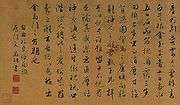 A Chinese traditional title epilogue written by Wen Zhengming in Ni Zan's portrait by Qiu Ying.(1470–1559)
A Chinese traditional title epilogue written by Wen Zhengming in Ni Zan's portrait by Qiu Ying.(1470–1559)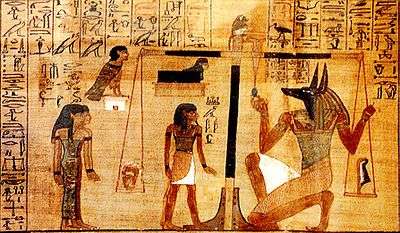 The Papyrus of Ani is a version of the Book of the Dead for the Scribe Ani. This vignette (small scene that illustrates the text) is Chapter for not letting Ani's heart create opposition against him in the God's Domain.[3]
The Papyrus of Ani is a version of the Book of the Dead for the Scribe Ani. This vignette (small scene that illustrates the text) is Chapter for not letting Ani's heart create opposition against him in the God's Domain.[3]
Medieval
Medieval religious illuminated manuscripts combine text and images. Among these books are the Gospel books of Insular art, created in the monasteries of the British Isles. The graphics in these books reflect the influence of the Animal style associated with the "barbarian" peoples of Northern Europe, with much use of interlace and geometric decoration.
 A page from Lindisfarne Gospels, c. 710
A page from Lindisfarne Gospels, c. 710 The Ada Gospels are one of a group of manuscripts, known to modern scholars as the Ada School. Its illuminations include an elaborate initial page for the Gospel of Matthew and portraits of Matthew, Mark and Luke. Late 8th century
The Ada Gospels are one of a group of manuscripts, known to modern scholars as the Ada School. Its illuminations include an elaborate initial page for the Gospel of Matthew and portraits of Matthew, Mark and Luke. Late 8th century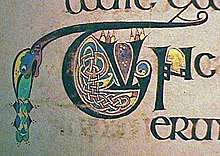 A graphic decoration in the Book of Kells, c. 800
A graphic decoration in the Book of Kells, c. 800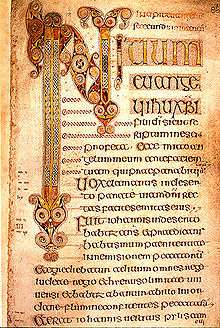 Opening page of Book of Durrow, 7th century
Opening page of Book of Durrow, 7th century
The Qur'an
In Islamic countries, calligraphy was a sacred aspect of the holy book of Islam, the Qur'an. Muslim scribes used black ink and golden paper to write and draw, using an angled alphabet called Kuffi, or Kufi. Such writings appeared in the 8th century and reached their apex in the 10th century. Later, decorations of the margins of pages, displaying a variety of graphic techniques, were added in order to beautify the book. In the 12th century, the Naskh alphabet was invented; it featured curves instead of the angled lines of Kufi script. Other styles, such as Mohaghegh, Reyhan, Sols, Reghaa, and Toghii, appeared later on.[4]
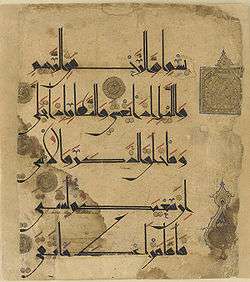 A page from a Persian Qur'an in the 11th century.
A page from a Persian Qur'an in the 11th century.- Graphic art in an Egyptian Qur'an of the 9th or 10th century.
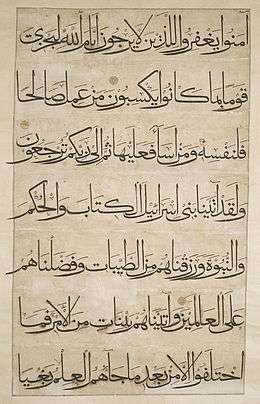 An Iranian Qur'an of the 15th century found in Uzbekistan.
An Iranian Qur'an of the 15th century found in Uzbekistan. A Qur'an featuring the Kuffi Alphabet of the 12th century.
A Qur'an featuring the Kuffi Alphabet of the 12th century.
Calligraphy
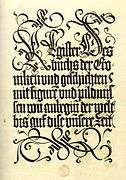 It has been suggested that calligraphy adds a mystical dimension to a text. Such mysticism appears to be consistent with the feeling that a religious text tries to convey. Many religious texts therefore have appeared in calligraphic editions, in order to evoke a spiritual feeling in the reader.
It has been suggested that calligraphy adds a mystical dimension to a text. Such mysticism appears to be consistent with the feeling that a religious text tries to convey. Many religious texts therefore have appeared in calligraphic editions, in order to evoke a spiritual feeling in the reader.Handscroll%2C_ink_and_colors_on_paper%2C_28.4_x_93.2_cm_National_Palace_Museum%2C_Taipei.jpg) The art of calligraphy in China goes back to 2000 BCE. Chinese calligraphy was used to communicate the philosophical ideas of Confucius and the Hundred Schools of Thought (諸子百家; zhūzǐ bǎijiā")[5]
The art of calligraphy in China goes back to 2000 BCE. Chinese calligraphy was used to communicate the philosophical ideas of Confucius and the Hundred Schools of Thought (諸子百家; zhūzǐ bǎijiā")[5] Calligraphy entered Japan from China in the 3rd century BCE, during its states wars. The Japanese used calligraphy to write their haiku on decorative banners.
Calligraphy entered Japan from China in the 3rd century BCE, during its states wars. The Japanese used calligraphy to write their haiku on decorative banners.
Playing cards
It is believed that playing cards were invented in China.[6] Chinese playing cards, as we understand the term today, date from at least 1294, when Yen Sengzhu and Zheng Pig-Dog were apparently caught gambling in Enzhou (in modern Shandong Province).[7] Cards entered Europe from the Islamic empire.[8] The earliest authentic references to playing cards in Europe date from 1377.[9] Europe changed the Islamic symbols such as scimitars and cups into graphical representations of kings, queens, knights and jesters. Different European countries adopted different suit systems. For instance, some Italian, Spanish and German decks of cards even today do not have queens.[10][11][12] During the 15th century, German printers introduced a woodblock printing technique to produce playing cards. Lower production costs enabled the printed playing cards' quick exportation throughout Europe. The substitution of wood-block printing and hand coloring with copper-plate engraving during the 16th century was the next significant innovation in the manufacture of playing cards. The mass printing of playing cards was revolutionized by the introduction of color lithography in the early 19th century.[13]
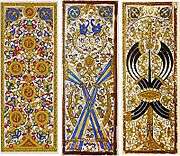 These are Card designs from the Mamluk Sultanate of Egypt. c. 1500. According to a passage in Ibn Taghri Birdi's HISTORY OF EGYPT, 1382-1469 A.D., the future sultan al-Malik al-Mu'ayyad won a large sum of money in a game of cards.[14] In the Islamic empire playing cards the suits were coins, cups, swords, and polo sticks.
These are Card designs from the Mamluk Sultanate of Egypt. c. 1500. According to a passage in Ibn Taghri Birdi's HISTORY OF EGYPT, 1382-1469 A.D., the future sultan al-Malik al-Mu'ayyad won a large sum of money in a game of cards.[14] In the Islamic empire playing cards the suits were coins, cups, swords, and polo sticks.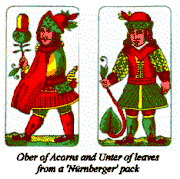 Germans introduced wooden blocks printing
Germans introduced wooden blocks printing
Communication
 Many medical organizations use the rod of Asclepius as their logo, since it symbolizes the healing arts. This kind of sign is called pictogram[15][16] The main advantage of a pictogram is that one does not need to be able to read or to understand a particular language in order to be able to understand the information it conveys.[17]
Many medical organizations use the rod of Asclepius as their logo, since it symbolizes the healing arts. This kind of sign is called pictogram[15][16] The main advantage of a pictogram is that one does not need to be able to read or to understand a particular language in order to be able to understand the information it conveys.[17] This is the Swedish traffic sign for no parking zone . The red circle with a diagonal line crossing it coveys the idea of "Not Allowed", and is called an ideogram.
This is the Swedish traffic sign for no parking zone . The red circle with a diagonal line crossing it coveys the idea of "Not Allowed", and is called an ideogram.
A rebus (Latin: "by things") is a kind of word puzzle which uses pictures to represent words or parts of words, such as "T,4,2" instead of "tea for two". In 1977, the New York State Department of Commerce recruited Milton Glaser, a productive graphic designer to work on a marketing campaign for New York State. Glaser created this rebus-style icon which became a major success and has continued to be sold for years.[18][19] Rebus has played an important role in creation of alphabets.
Heraldry
Heraldry is the practice of designing and displaying coat of arms and heraldic badge and is rather common among all nations. For example, Romans used eagle as their coat of arms, French used fleur de lis, and Persians used the sign of their god, Ahura Mazda. Historically, it has been variously described as "the shorthand of history"[20] and "the floral border in the garden of history.".[21] It comes from the Germanic compound *harja-waldaz, "army commander".[22] The origins of heraldry lie in the need to distinguish participants in combat when their faces were hidden by iron and steel helmets.[23] Eventually a formal system of rules developed into ever more complex forms of heraldry.[24]
 This is the imperial Coat of arms of Charles V, Holy Roman Emperor. From the time of Otto the Great onward, the various German princes elected one of their peers as King of the Germans, after which he would be crowned as emperor by the Pope. The last emperor to be crowned by the pope was Charles V; all emperors after him were technically emperors-elect, but were universally referred to as Emperor.
This is the imperial Coat of arms of Charles V, Holy Roman Emperor. From the time of Otto the Great onward, the various German princes elected one of their peers as King of the Germans, after which he would be crowned as emperor by the Pope. The last emperor to be crowned by the pope was Charles V; all emperors after him were technically emperors-elect, but were universally referred to as Emperor..svg.png) This the coat of arm of Albert of Sweden. He was the King of Sweden from 1364, and in 1384 he inherited the ducal title of Mecklenburg and united the two countries in a personal union.
This the coat of arm of Albert of Sweden. He was the King of Sweden from 1364, and in 1384 he inherited the ducal title of Mecklenburg and united the two countries in a personal union. Like Western heraldry, Japanese mons were initially held only by aristocratic families, and were gradually adapted by commoners. Japanese traditional formal attire generally displays the mon of the wearer. Commoners without mon often used that of their patron or the organization they belonged to. This the coat of arm of Gion Mamori of Japan.
Like Western heraldry, Japanese mons were initially held only by aristocratic families, and were gradually adapted by commoners. Japanese traditional formal attire generally displays the mon of the wearer. Commoners without mon often used that of their patron or the organization they belonged to. This the coat of arm of Gion Mamori of Japan. This is the White Rose of York, a white heraldic rose, which is the symbol of the House of York. Traditionally the origins of the emblem are said to go back to Edmund of Langley in the 14th century, the first Duke of York and the founder of the House of York as a Cadet branch of the then ruling House of Plantagenet.[25] The actual symbolism behind the rose has religious connotations as it represents the Virgin Mary, who was often called the Mystical Rose of Heaven.[25][26]
This is the White Rose of York, a white heraldic rose, which is the symbol of the House of York. Traditionally the origins of the emblem are said to go back to Edmund of Langley in the 14th century, the first Duke of York and the founder of the House of York as a Cadet branch of the then ruling House of Plantagenet.[25] The actual symbolism behind the rose has religious connotations as it represents the Virgin Mary, who was often called the Mystical Rose of Heaven.[25][26]
Logos and trademarks
A trademark is a distinctive sign or indicator used by an individual, company or other entity to identify its products or services and to distinguish them from those of other producers. A trademark is a type of intellectual property, and typically a name, word, phrase, logo, symbol, design, image, or a combination of these elements.[27]

 Google is a young high-tech company, and its logotype created by Ruth Kedar reminds us of the Mondrian minimalism. Kedar has emphasized the playfulness of her design, and its simplicity that conveys an illusion of non-design. According to her " The colors evoke memories of child play, but deftly stray from the color wheel strictures so as to hint to the inherent element of serendipity creeping into any search results page ... The texture and shading of each letter is done in an unobtrusive way resulting in lifting it from the page while giving it both weight and lightness.[30]
Google is a young high-tech company, and its logotype created by Ruth Kedar reminds us of the Mondrian minimalism. Kedar has emphasized the playfulness of her design, and its simplicity that conveys an illusion of non-design. According to her " The colors evoke memories of child play, but deftly stray from the color wheel strictures so as to hint to the inherent element of serendipity creeping into any search results page ... The texture and shading of each letter is done in an unobtrusive way resulting in lifting it from the page while giving it both weight and lightness.[30]
Rebranding
Rebranding means staying relevant as competition heats up and sales start to stagnate. In such circumstances companies often seek to breathe new life into the brand through rebranding. The idea behind it is that the assumptions made when the brand was established may no longer hold true.[31]
Signage of culture and peace
 This flag of the Olympic Games that has been designed by Pierre de Coubertin reminds the viewer of the minimalism of Mondrian. According to Coubertin "This design is symbolic; it represents the five continents of the world, united by Olympism, while the six colours are those that appear on all the national flags of the world at the present time"[32]
This flag of the Olympic Games that has been designed by Pierre de Coubertin reminds the viewer of the minimalism of Mondrian. According to Coubertin "This design is symbolic; it represents the five continents of the world, united by Olympism, while the six colours are those that appear on all the national flags of the world at the present time"[32]
The logo of the Socialist Party (France). The rose symbol represents; community (the flower's petals), socialism (its red color), taking care of those who are less able to compete (the fragility), the struggle (the thorns), cultural life (beauty). Historically, the red rose became the party's emblem during the nineteen-seventies. The fist symbol was a sign of resistance. Although the Mitterrand Socialists turned the fist into a graphic holding a rose.[33]
Known worldwide by its panda logo, the Switzerland-based World Wildlife Fund (WWF) participates in international efforts to protect endangered species and their habitats.[34]
Médecins Sans Frontières, or Doctors Without Borders, is best known for its humanitarian projects in war-torn regions and developing countries facing endemic disease. Their logo using a minimalist approach creates its visual impact.[35]
Information signs: ISOTYPE
In 1921, Otto Neurath, an Austrian social scientist, introduced graphic design in order to facilitate the understanding of various social and economic trends through the creative use of statistical charts. In 1924, Neurath advocated the establishment of the Museum of Economy and Society, an institution for public education and social information. In May 1925, the Museum's first graphical displays was opened to the public. The exhibition showed various complicated social and economic trends. By using charts which were to be intuitive and interesting the attempt was to make those concepts easy to grasp. This style of presentation at the time was called the Viennese method, but now it is known as ISOTYPE charts (International System of Typographic Picture Education).[36]
Otto Neurath (1882–1945) was an enthusiast of sociology. After obtaining his PhD he worked on planning the war economy of the Austro-Hungarian empire. However, by 1919 he was engaged in the planning for a wholly new economic system of the chaotic and short-lived Bavarian Soviet Republic. He proposed for the abolition of money, but before this could be implemented, the republic was bloodily overthrown by Weimar's Social Democrats. Neurath escaped to Vienna, where he became an activist for the self-help squatters' movement. In the 1920s he joined the Vienna Circle of Logical Positivists, who attempted to establish a scientific foundation for philosophy; and at the same time he pioneered the graphic methods that became Isotype and were shown in the "Museum of Society and Economy". He fled Vienna after the collapse of its social democratic city government in 1934. Neurath's final years were spent in Britain, as postwar planner for the Midlands town of Bilston.[37]
As Lupton argues: Neurath suggested "two central rules for generating the vocabulary of international pictures: reduction, for determining the style of individual signs; and consistency, for giving a group of signs the appearance of a coherent system". Reduction means finding the simplest expression of an object. For instance, silouette is a basic technique for reduction. It emulates the shadow of the image without any human intervention. Thus, it is a natural cast rather than a cultural interpretation. The sign as geometric representation of reality is both a rhetorical connotation and a practical technique for many symbol designers. Martin Krampen suggested "simplified realism;" he urged designers to "start from silhouette photographs of objects...and then by subtraction...obtain silouette pictographs."[38]
Gerd Arntz (1900–1988) was born in a German family of traders and manufacturers. He was a socio-political activist in Düsseldorf, where he joined a movement that aimed to turn Germany into a radical-socialist state form. As a revolutionary artist, Arntz was connected to the Cologne-based ‘progressive artists group’ (Gruppe progressiver Künstler Köln) and depicted the life of workers and the class struggle in abstracted figures on woodcuts. Published in leftist magazines, his work was noticed by Otto Neurath who for his ‘Vienna method of visual statistics’ needed a designer of pictograms that could summarize a subject at a glance. Neurath invited the young artists to come to Vienna in 1928, and work on further developing his ISOTYPE. Arntz designed around 4000 different pictograms and abstracted illustrations for this system.[39]
Neurath's motto was ‘words divide, images unite’. Many of his designs together with those of his protégé Gerd Arntz were the forebears of pictograms we now encounter everywhere, such as the man and woman on toilet doors. As Marina Vishmidt suggests: "Neurath's pictograms owe much to the Modernist belief that reality may be modified by being codified – standardised, easy-to-grasp templates as a revolution in human affairs.[40]
Olympic pictograms
The logos and pictograms for Olympic Games change every four years and the sponsoring city develops its own logos. Pictograms first appeared at the Olympics in London in 1948. They came into wide use, since they simultaneously communicate a message to a large number of people who speak different languages. In the absence of such signs in venues such as Olympic village there would be a need for many written signs in different languages, for example for rowing such as; Roning، Κωπηλασία، Aviron, قایق رانی، and ボート競技 which not only would be costly but also may confuse the viewers. Symbols for individual sports developed by Masasa Katzoumie and Yoshiro Yamashita in Tokyo Olympics in 1964.[41]
Pictograms in Mexico Olympic Games, 1968. A group of Olympic identity program designers collaborated on the creation of these symbols, which were employed to designate the events and installations for both the sports program and the Cultural Olympiad.[42]
Inspired by the pictograms of Gerd Arntz, Otl Aicher, design director for the Munich 1972 games, in the words of Michael Bierut "developed a set of pictograms of such breathtaking elegance and clarity that they would never be topped. Aicher (1922-1991), founder of the Ulm design school and consultant to Braun and Lufthansa, was the quintessential German designer: precise, cool and logical".[43]
Olympic Games pictograms of Barcelona in 1992 were influenced by Aicher's work. However, the geometric shapes were abandoned in favour of the characteristic line of the emblem created by Josep. M. Trias and its stylized simplification of the human body in three parts.[44]
Twenty-four sport pictograms and a series of sport illustrations for the 2010 Winter Games are created by Dutch illustrator Irene Jacobs of I'm JAC Design.
Astronomical, statistical and scientific charts
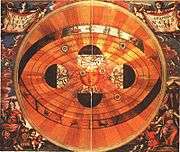 Astronomical charts have a long history. For instance, an engraving of an ancient Egyptian diagram of the heavens from the Temple of Dendara, depicts the sky on the date of the founding of the temple in 54 BC. The above chart is an astronomical map of the sky drawn by Nicholas Copernicus in 1543 that replaced an earlier chart by Cellarius showing the Earth centred universe.[45]
Astronomical charts have a long history. For instance, an engraving of an ancient Egyptian diagram of the heavens from the Temple of Dendara, depicts the sky on the date of the founding of the temple in 54 BC. The above chart is an astronomical map of the sky drawn by Nicholas Copernicus in 1543 that replaced an earlier chart by Cellarius showing the Earth centred universe.[45]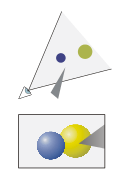 In this graphic chart the position of two planets in relation to a viewer, and their position as they appear to a specific viewer is shown. These types of charts are used in various textbooks to describe various scientific phenomena. They are used as well by manufacturers for their manuals in order to help the buyers to become familiar with the working of a gadget.[46]
In this graphic chart the position of two planets in relation to a viewer, and their position as they appear to a specific viewer is shown. These types of charts are used in various textbooks to describe various scientific phenomena. They are used as well by manufacturers for their manuals in order to help the buyers to become familiar with the working of a gadget.[46] This is a bubble chart, which can show the relationship between three variables. These charts facilitate the understanding of the social, economical, medical, and other scientific relationships.[47]
This is a bubble chart, which can show the relationship between three variables. These charts facilitate the understanding of the social, economical, medical, and other scientific relationships.[47]
Statistics is becoming increasingly more important in modern society. Various computer software can easily transform a large set of data into charts, graphs, and statistics of various types in an attempt to provide us with succinct information to make decisions.[48]
Dynamic designs and computer animation
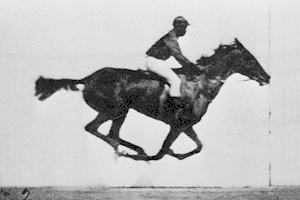 Computer animation creates the illusion of motion by viewing a succession of computer-generated still images. In the past, animation was produced by filming painted sequences on plastic or paper cels. The above animation was created from photos by Eadweard Muybridge in 1887. Computer animation can be used to produce special effects for educational purposes, such as the study of planetary motions, particle collisions, or fluid dynamics.[49]
Computer animation creates the illusion of motion by viewing a succession of computer-generated still images. In the past, animation was produced by filming painted sequences on plastic or paper cels. The above animation was created from photos by Eadweard Muybridge in 1887. Computer animation can be used to produce special effects for educational purposes, such as the study of planetary motions, particle collisions, or fluid dynamics.[49] Dynamic graphics are used to facilitate understanding of concepts in science, engineering, medicine, education, and business. Computer graphics facilitates the production of images that range in complexity from simple line drawings to three-dimensional reconstructions of data. The evolution of a phenomenon through time and its interactions with other elements can be shown through animation.[50]
Dynamic graphics are used to facilitate understanding of concepts in science, engineering, medicine, education, and business. Computer graphics facilitates the production of images that range in complexity from simple line drawings to three-dimensional reconstructions of data. The evolution of a phenomenon through time and its interactions with other elements can be shown through animation.[50] In this 3-D dynamic design a house is studied from various angles. These types of animations can be very useful in the study of various objects. They can also be used to study the evolution of a process through time.:[51]
In this 3-D dynamic design a house is studied from various angles. These types of animations can be very useful in the study of various objects. They can also be used to study the evolution of a process through time.:[51] The art of dynamic designs is still in its infancy. With the availability of sophisticated computer graphics techniques the horizon has been expanded enormously for graphic designers.
The art of dynamic designs is still in its infancy. With the availability of sophisticated computer graphics techniques the horizon has been expanded enormously for graphic designers.
Pioneers of modern graphics and industrial design
.svg.png) In 1907, AEG (Allgemeine Elektricitäts-Gesellschaft) retained Peter Behrens, a German architect and designer, as artistic consultant. He designed the entire corporate identity (logotype, product design, publicity, etc.) and for that he is considered the first industrial designer in history. He never became an employee of AEG, but worked as an artistic consultant.[52]
In 1907, AEG (Allgemeine Elektricitäts-Gesellschaft) retained Peter Behrens, a German architect and designer, as artistic consultant. He designed the entire corporate identity (logotype, product design, publicity, etc.) and for that he is considered the first industrial designer in history. He never became an employee of AEG, but worked as an artistic consultant.[52] Paul Rand an American graphic designer, is best known for his corporate logo designs. His career began with a part-time position creating stock images for a syndicate that supplied graphics to various newspapers and magazines.[53] Between his class assignments and his work, Rand was able to amass a fairly large portfolio, largely influenced by the German advertising style Sachplakat (object poster) as well as the works of Gustav Jensen.[54]
Paul Rand an American graphic designer, is best known for his corporate logo designs. His career began with a part-time position creating stock images for a syndicate that supplied graphics to various newspapers and magazines.[53] Between his class assignments and his work, Rand was able to amass a fairly large portfolio, largely influenced by the German advertising style Sachplakat (object poster) as well as the works of Gustav Jensen.[54]
Raymond Loewy was one of the best known industrial designers of the 20th century. Born in France, he spent most of his professional career in the United States. Among his many contributions were the Shell logo, the Greyhound bus, the S-1 locomotive, the Lucky Strike package, Coldspot refrigerators and the Studebaker Avanti. Loewy was first approached by the greyhound corporation to redesign its logo. The company's logo looked like a 'fat mongrel' he said. So, he created a slimmed-down version that is still used today.[55]
William Golden is one of the pioneers of American graphic design. He was born in lower Manhattan, the youngest of twelve children. His only formal schooling was at the Vocational School for Boys, where he learned photoengraving and the basics of commercial design. In conjunction with the Didot typeface, Golden developed the famous CBS Eye logo. It has been suggested that the eye was inspired by an article in Alexey Brodovitch's Portfolio about the subject of Shaker design.[56]
Placards and posters
Placard and posters existed from the ancient times. The Persian reliefs that depicted the important historical events; and the Greek axons and the Roman Albums, with their decorative designs and announcements, were quite similar to today's posters. In ancient Greece the name of athletes, and games schedules were written on columns that were slowly turning on an axis. Romans used whitewashed walls in their markets in which sellers, money lenders, and slave traders wrote their announcements and advertised for their products, and to attract the attention of customers they added attractive designs to their announcements.[57]
Ancient reliefs
Emergence of the print and design industry
Around 1450, Johann Gutenberg's printing press made books widely available in Europe. The book design of Aldus Manutius developed the book structure which would become the foundation of western publication design. With the development of the lithographic process, invented by a Czech named Alois Senefelder in 1798 in Austria, the creation of posters become feasible. Although handmade posters existed before, they were mainly used for government announcements. William Caxton, who in 1477 started a printing company in England, produced the first printed poster.[58] In 1870, the advertising poster emerged.[59][60]
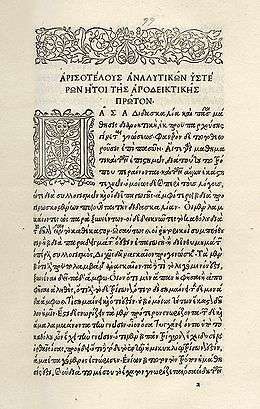 Aristotle printed by Aldus Manutius, 1495-98 (Libreria antiquaria Pregliasco, Turin)
Aristotle printed by Aldus Manutius, 1495-98 (Libreria antiquaria Pregliasco, Turin)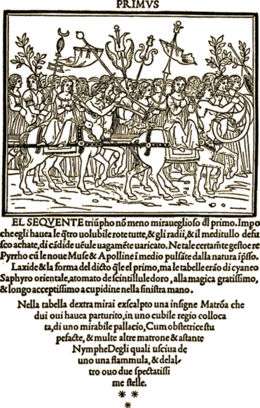 A page from Francesco Colonna's Hypnerotomachia Poliphili, printed by Aldus Manutius
A page from Francesco Colonna's Hypnerotomachia Poliphili, printed by Aldus Manutius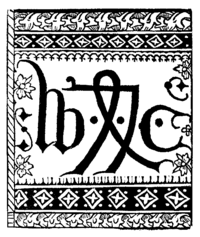 The printer's device of William Caxton, 1478.
The printer's device of William Caxton, 1478.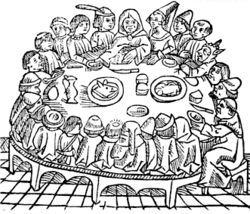 A woodcut from William Caxton's second edition of the Canterbury Tales printed in 1483.
A woodcut from William Caxton's second edition of the Canterbury Tales printed in 1483.
Engraving
Engraving is the practice of incising a design onto a hard, usually flat surface, by cutting grooves into it. The process was developed in Germany in the 1430s from the engraving used by goldsmiths to decorate metalwork. Engravers use a hardened steel tool called a burin to cut the design into the surface, most traditionally a copper plate.[61] Gravers come in a variety of shapes and sizes that yield different line types.
 Theodor de Bry (1528 – 1598) was an engraver, goldsmith and editor. An engraving portrait of Theodorus de Bry, by himself and confirming his origins from Liège, in Latin "Leodiensis", between brackets: (a city at that time belonging neither to Flanders or Wallonia, or even to Belgium).
Theodor de Bry (1528 – 1598) was an engraver, goldsmith and editor. An engraving portrait of Theodorus de Bry, by himself and confirming his origins from Liège, in Latin "Leodiensis", between brackets: (a city at that time belonging neither to Flanders or Wallonia, or even to Belgium). Albrecht Dürer, St Jerome in his study. Albrecht Dürer was a German painter and printmaker. (1514)
Albrecht Dürer, St Jerome in his study. Albrecht Dürer was a German painter and printmaker. (1514) Ecce Homo, Engraving, 15th century, by Martin Schongauer(c. 1448 – 1491). He was a German engraver and painter, and was the most important German printmaker before Albrecht Dürer.
Ecce Homo, Engraving, 15th century, by Martin Schongauer(c. 1448 – 1491). He was a German engraver and painter, and was the most important German printmaker before Albrecht Dürer.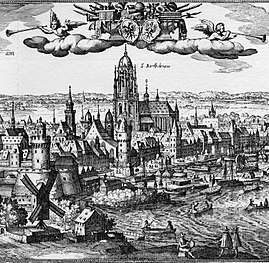 Matthäus Merian, View of Frankfurt, between 1612 and 1619. Merian was a notable Swiss engraver.
Matthäus Merian, View of Frankfurt, between 1612 and 1619. Merian was a notable Swiss engraver.
Etching
Etching is the process of using strong acid or mordant to cut into the unprotected parts of a metal surface to create a design in intaglio in the metal. This technique is believed to have been invented by Daniel Hopfer (c. 1470-1536) of Augsburg, Germany, who decorated armour in this way, and applied the method to printmaking. Etching soon came to challenge engraving as the most popular printmaking medium. Its great advantage was that, unlike engraving which requires special skill in metalworking, etching is relatively easy to learn for an artist trained in drawing.
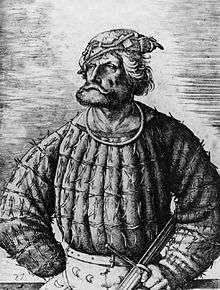 Court jester of Emperor Maximilian I. Etching by Daniel Hopfer, (1493).
Court jester of Emperor Maximilian I. Etching by Daniel Hopfer, (1493).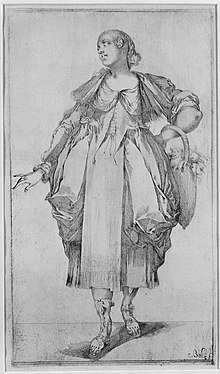 Gardener with basket, c. 1612, Etching by Jacques Bellange . He was an artist and printmaker from Lorraine, now in France.(c. 1575 - 1616).
Gardener with basket, c. 1612, Etching by Jacques Bellange . He was an artist and printmaker from Lorraine, now in France.(c. 1575 - 1616)..jpg) Pornocrates by Félicien Rops. He was a Belgian artist, and printmaker in etching and aquatint, 1896.
Pornocrates by Félicien Rops. He was a Belgian artist, and printmaker in etching and aquatint, 1896._British_Museum.jpg) William Blake's Ancient of Days, etching/watercolour, (1794).
William Blake's Ancient of Days, etching/watercolour, (1794).
Modern graphic design
In the second half of the 19th century William Morris's Kelmscott Press produced many historicist graphic designs, and created a collectors market for this kind of art. In Oxford he associated with artists like Burne-Jones, and Dante Gabriel Rossetti. Together they formed the Pre-Raphaelites group, and their ideas influenced the modern graphic design considerably.[62][63]
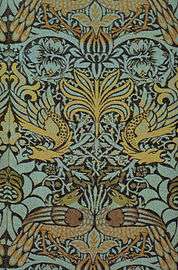 This fabric design called Peacock and Dragon, which is the work of William Morris (1878) is an example of decorative graphic design. Such designs was revived during the 1960s with the emergence of the hippie movement.
This fabric design called Peacock and Dragon, which is the work of William Morris (1878) is an example of decorative graphic design. Such designs was revived during the 1960s with the emergence of the hippie movement.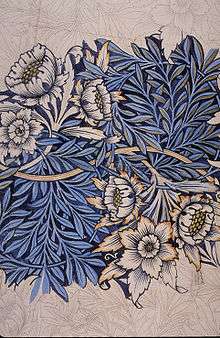 This Morris Tulip and Willow design (1873) is another example of decorative graphics. By using a diagonal blue, with only some suggestion of orange the artist tries to create a harmonious color scheme that could be used effectively in the design of a poster or other graphic design media.
This Morris Tulip and Willow design (1873) is another example of decorative graphics. By using a diagonal blue, with only some suggestion of orange the artist tries to create a harmonious color scheme that could be used effectively in the design of a poster or other graphic design media..jpg) This is the first page of The Nature of Gothic by John Ruskin which was published by Kelmscott Press of William Morris. The decorative design was the revival of the Gothic style in graphic design.
This is the first page of The Nature of Gothic by John Ruskin which was published by Kelmscott Press of William Morris. The decorative design was the revival of the Gothic style in graphic design.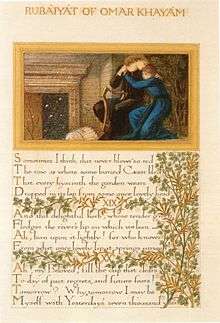 This book of poetry, called Rubaiyat, by the famous Persian poet Omar Khayyam, is an example of early modern graphic design cooperation. The graphic composition of calligraphy and its decorative design are by Morris and the painting is by Burne-Jones.
This book of poetry, called Rubaiyat, by the famous Persian poet Omar Khayyam, is an example of early modern graphic design cooperation. The graphic composition of calligraphy and its decorative design are by Morris and the painting is by Burne-Jones.
In 1917, Frederick H. Meyer, director and instructor at the California School of Arts and Crafts, taught a class entitled “Graphic Design and Lettering”.[64]
Posters Post-World War II
After the Second World War, with the emergence new color printing technology and particularly appearance of computers the art of posters underwent a new revolutionary phase. People can create color poster on their laptop computers and create color prints at a very low cost. Unfortunately, the high cost sophisticated printing processes can only be afforded mostly by the government entities and large corporations. With the emergence of internet the role of posters in conveying information has greatly diminished. However, some artist still use the chromolithography in order to create works of arts in the form of print. In this regard the difference between painting and print has been narrowed considerably.
Psychedelic design
The word "psychedelic" means "mind manifesting". Psychedelic art is art inspired by the psychedelic experience induced by drugs, and refers above all to the art movement of the 1960s counterculture. Psychedelic visual arts were a counterpart to psychedelic rock music. Concert posters, album covers, lightshows, murals, comic books, underground newspapers and more reflected revolutionary political, social and spiritual sentiments inspired by psychedelic states of consciousness.[65]
Although San Francisco remained the hub of psychedelic art into the early 1970s, the style also developed internationally. Pink Floyd worked extensively with London-based designers, Hipgnosis to create graphics to support the concepts in their albums like this cover of Soundtrack from the Film 'More'. Life magazine's cover and lead article for the September 1, 1967 issue at the height of the Summer of Love focused on the explosion of psychedelic art on posters and the artists as leaders in the hippie counterculture community.
Yellow Submarine was a milestone in graphic design, inspired by the new trends in art, it sits alongside the dazzling Pop Art styles of Andy Warhol, Martin Sharp, Alan Aldridge and Peter Blake. Heinz Edelman was hired by TVC as the art director for this film. Before making Yellow Submarine, TVC had produced The Beatles, a 39 episode TV series "produced" by Al Brodax and King Features. Despite the critical acclaim of his design work for the film, Edelman never worked on another animated feature.[66]
Peter Max's art work was a part of the psychedelic movement in graphic design. His work was much imitated in commercial illustration in the late 1960s and early 1970s. In 1970, many of Max's products and posters were featured in the exhibition "The World of Peter Max" which opened at the M.H. de Young Memorial Museum in San Francisco. He appeared on the cover of Life magazine with an eight-page feature article as well as The Tonight Show Starring Johnny Carson and The Ed Sullivan Show.[66]
Poster design in Japan
The distinctive aesthetics of Japanese graphic design have been admired over many decades, winning awards at prestigious international venues.[67]
The works of Japanese graphic designers are noted for their resourcefulness, powerful visual expression and extraordinary technical quality of print.[68]
The distinctive artistic language and typographic sophistication show particularly in Japanese poster-design. The Japanese poster is a compelling pictorial medium and an original work of art, reflecting in full the designer's creative talent.
Chinese cultural revolution
The poster "Revolution promotes production", created by He Shuxui, celebrates traditional ceramic painting techniques. A plaque in the background commemorates a group of ceramic workers as an outstanding productive unit, 1974.[69]
A worker named Wang Qing Cang created the poster "The three countries of Indo Zhina (Lao, Cambodia, Vietnam) will win!". On the upper left side, it says "Enemies are getting sicker and sicker every day, and we are getting better and better every day." (The U.S. supported Indo Zhina (Indochina) governments while China supported their communist guerilla forces.) October 1964.[70]
The poster "Mao Ze Dong at Jing Gang Mountain" depicts a young Mao Ze Dong sitting against a background of Mount Jing Gang. Jing Gang Shan (Jing Gang Mountain) symbolizes the Mao Ze Dong leadership and his vision to unite the oppressed masses to fight against and fight against the ruling class. Created by Liu Chun Hua and Wang Hui, October 1969.[71]
The poster, "Time is Money", features the famous Canadian doctor Norman Bethune (Dr. Bai Qiuen in Chinese), racing to rescue another patient. Bethune became an early proponent of universal health care, the success of which he observed during a visit to the Soviet Union. As a doctor in Montreal, Bethune frequently sought out the poor and gave them free medical care. As a thoracic surgeon, he traveled to Spain (1936–1937) and to China (1938–1939) to perform battlefield surgical operations on war casualties. Created by Zhang Xin Gua. Hebei People's Publishing House.[72]
Culture and politics
Richard Avedon was an American photographer. Avedon capitalized on his early success in fashion photography and expanded into the realm of fine art. This is a solarised poster portraits of the Beatles, originally produced for 9 January 1967 edition of the American magazine Look.
The Barack Obama "hope" poster is an iconic image of Barack Obama designed by artist Shepard Fairey. The image became one of the most widely recognized symbols of Obama's campaign message, spawning many variations and imitations, including some commissioned by the Obama campaign. In January 2009, after Obama had won the election, Fairey's mixed-media stenciled portrait version of the image was acquired by the Smithsonian Institution for its National Portrait Gallery.
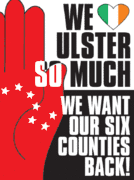 This political poster by Tiocfaidh Ár Lá about Ulster.
This political poster by Tiocfaidh Ár Lá about Ulster.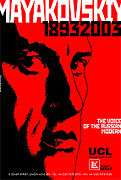 Andrew Pavlovsky poster of Poet MAYAKOVSKIY (2003). This poster is a graphic illustration of a true interest to Constructivism in Russia today. This Art Movement (Constructivism) was almost always in demand in Russia and it can become one of principal trends now. Some of the contemporary Russian artists and art historians have already suggested the new term - Additive Constructivism. It emphasizes the return to modernism, which starts to significantly push out the postmodern art practices. It's not a postmodern performance. The Constructivist color solution proves that so it is.
Andrew Pavlovsky poster of Poet MAYAKOVSKIY (2003). This poster is a graphic illustration of a true interest to Constructivism in Russia today. This Art Movement (Constructivism) was almost always in demand in Russia and it can become one of principal trends now. Some of the contemporary Russian artists and art historians have already suggested the new term - Additive Constructivism. It emphasizes the return to modernism, which starts to significantly push out the postmodern art practices. It's not a postmodern performance. The Constructivist color solution proves that so it is.
do
Computer aided graphic design in posters
With the arrival of computer aided graphic design an assortment of novel effects, digital techniques, and innovative styles have been emerged in poster designs. With software such as Adobe Photoshop, Corel and Windows' Paint program, image editing has become very cheap, and artists can experiment easily with a variety of color schemes, filters and special effects. For instance, utilizing various filters of Photoshop, many artists have created "vectored" designs in posters where a photographic image is solarized, sharpened, rendered into watercolor or stained glass effects or converted into bare lines with block colors. Other designs created soft or blurry styles, ripple or cascade effects and other special filters.
Advertising
Graphic design is used in advertising to announce a persuasive message by an identified sponsor; or a promotion by a firm of its products to its existing and potential customers. Egyptians used papyrus to make sales messages and wall posters. Commercial messages and political campaign displays have been found in the ruins of Pompeii and ancient Arabia. Lost and found advertising on papyrus was common in Ancient Greece and Ancient Rome. Wall or rock painting for commercial advertising is another manifestation of an ancient advertising form, which is present to this day in many parts of Asia, Africa, and South America.[73]
Advertising in the 19th century
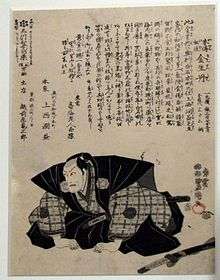 This advertising flier from 1806 is for a traditional medicine called Kinseitan. Display in the Edo Tokyo Museum.
This advertising flier from 1806 is for a traditional medicine called Kinseitan. Display in the Edo Tokyo Museum.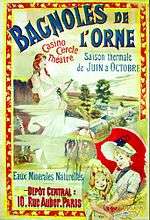 This is a 19th-century advertising poster for the hydrotherapic baths of Bagnoles de l'Orne (France).
This is a 19th-century advertising poster for the hydrotherapic baths of Bagnoles de l'Orne (France).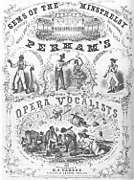 This is a playbill for Perham's Opera Vocalists, 1856.
This is a playbill for Perham's Opera Vocalists, 1856.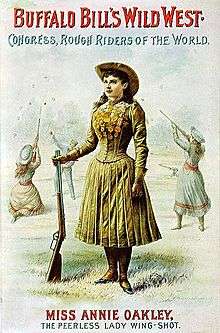 This poster from the second half of the 1880s advertises for Buffalo Bill's Wild West show, advertising "Miss Annie Oakley, the peerless lady wing-shot".
This poster from the second half of the 1880s advertises for Buffalo Bill's Wild West show, advertising "Miss Annie Oakley, the peerless lady wing-shot".
Advertising in the early 20th century
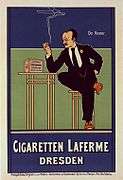 This is a German poster by Fritz Rehm for Laferme Cigarettes (published 1896-1900)
This is a German poster by Fritz Rehm for Laferme Cigarettes (published 1896-1900)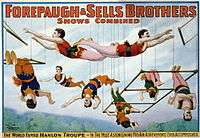 Circus poster, 1899. "Forepaugh & Sells Brothers Shows Combined. The world famed Hanlon Troupe in the most astonishing mid-air achievements ever accomplished."
Circus poster, 1899. "Forepaugh & Sells Brothers Shows Combined. The world famed Hanlon Troupe in the most astonishing mid-air achievements ever accomplished."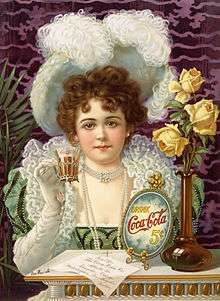 "Drink Coca-Cola 5¢", an 1890s advertising poster showing a woman in fancy clothes (partially vaguely influenced by 16th- and 17th-century styles) drinking Coke.
"Drink Coca-Cola 5¢", an 1890s advertising poster showing a woman in fancy clothes (partially vaguely influenced by 16th- and 17th-century styles) drinking Coke.
German Plakatstil, "Poster style"
In the early 20th century, Germany became the cradle of many of the avant-garde art movements particularly for posters. This created the "Plakatstil" or "Poster style" movement. This movement became very influential and had a considerable impact on the graphic design for posters. Posters in this style would feature few but strong colours, a sharp, non-cluttered, minimal composition and bold, clear types.[74]
Ludwig Hohlwein
Ludwig Hohlwein was born in Germany in 1874. He was trained and practiced as an architect until 1906 when he switched to poster design. Hohlwein's adaptations of photographic images was based on a deep and intuitive understanding of graphical principles. His creative use of color and architectural compositions dispels any suggestion that he uses photos as a substitute for creative design.
for Riquet Pralinen Tea c. 1920–1926. Hohlwein was born in the Rhine-Main region of Germany, though he and his work are associated with Munich and Bavaria in southern Germany. There were two schools of Gebrauchsgrafik in Germany at the time, North and South. Hohlwein's high tonal contrasts and a network of interlocking shapes made his work instantly recognizable.
Poster historian Alain Weill comments that "Hohlwein was the most prolific and brilliant German posterist of the 20th century... Beginning with his first efforts, Hohlwein found his style with disconcerting facility. It would vary little for the next forty years. The drawing was perfect from the start, nothing seemed alien to him, and in any case, nothing posed a problem for him. His figures are full of touches of color and a play of light and shade that brings them out of their background and gives them substance"[75]
Lucian Bernhard
Over the course of his career, which lasted well into the 1950s, Lucian Bernhard became a prolific designer not only of innovative posters but of trademarks, packaging, type, textiles, furniture, and interior design.
Advertising in the 1920-30 era
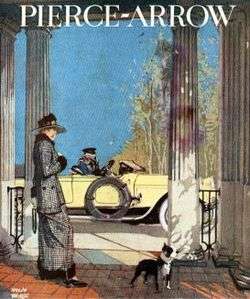 Pierce-Arrow auto ad, from advertisement in Life magazine, 1919
Pierce-Arrow auto ad, from advertisement in Life magazine, 1919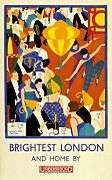 The London Underground Electric Railway Company Ltd published this poster in 1924.
The London Underground Electric Railway Company Ltd published this poster in 1924.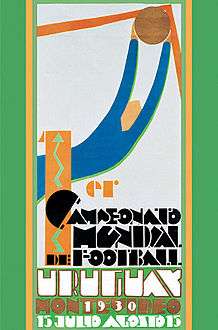 This is an official soccer poster for World Cup in Uruguay, 1930.
This is an official soccer poster for World Cup in Uruguay, 1930.
1972 Olympics and Otl Aicher posters
The internationally recognized artist Otl Aicher was a graphic designer, urban planner, photographer, and the mastermind behind the imagery for the 1972 Munich Olympics and the Rotis typeface. Growing as a child in Nazi Germany, Aicher, along with his friends Hans and Sophie Scholl, organized the anti-Nazi political organization Die Weisse Rose (the White Rose). In 1943, the Scholls and Aicher were arrested by the Nazi party. While Aicher was released, the Scholls went to trial where they were found guilty of treason and executed. After the war Aicher went on to help rebuild his ravaged city of Ulm and to found the influential international school of design, Hochschule für Gestaltung (HfG).[76]
In Munich's original bid for 1972 Olympic one of the main promises was to create a synthesis between sport and art. Otl Aicher was appointed as the head of the committee's visual design group, and his mandate was to deploy art in a relatively new role of promoting this global public event. From the start, posters were high on the agenda of the organizing committee, and ideas were discussed as early as September 1967 to publish a series of art posters that would ‘relate artistic activity to the Olympic Games and engage the best artists to collaborate’, and also to commission an internationally known artist for the official poster.[77]
Otl Aicher created the official posters for the 1972 Olympic Games in Munich. As he pointed out in his essay "Entwurf der Moderne"[78] (Designing the Modern Era), the German word entwerfen, meaning "to draft "or "design", also contains the verb werfen, meaning "to throw". But where? To whom? What? And with what intention? As Benjamin Secher writes: "He devised an invigorating, almost Day-glo palette for the Olympics that was utterly free of red and black - banned for their association with the German flag. Athletes depicted in the official posters for each sport had their uniforms stripped of any national identifier, leaving the emphasis firmly on individual effort. Even the logo for the Games, a graphic of a radiant sun, hammered home the message of universality and, above all, optimism."[79]
Aicher developed a comprehensive system to articulate the games' character across a wide range of materials, from signage to printed pieces and even staff uniforms. As the introduction to his exhibition at San Francisco Museum of Modern Art states: "His works including official posters and sporting event tickets, demonstrate the design tools Aicher used to join individual elements to the collective: structural grids, a bold and animating color palette, and ingenious pictograms. Aicher's orderly and pleasant design nimbly carried the weight of modern German history as it repositioned the nation's hospitality on the world stage".
This is a poster of 1972 Olympics Yachting in Germany designed by Otl Aicher. Using a bright color scheme, borrowed from 60s pop art and psychedelic art, and combining it with German modernism Aicher creates this visual graphic program.
Current advertising
Nike's My Butt is Big poster appears to convey a bold and honest statement. The only part of a body in the picture is a butt. The text of a poem on the right repeats the curved form of the woman's bottom which is repeated again with some vividly colored splosh of red and purple dots in the background. The background is white, which contrasts with the darker skin of the model. The statement, "My butt is big" is red and larger than the rest of the poem. Image:Courvoisier Cognac.jpg | This is a modern advertisement poster for Courvoisier Cognac. A balanced composition of the hands, feet, and face of the figure on a black background appear to convey the message of this poster.
This is a look alike poster advertisement for Wendy's "where's the Beef?" campaign. In the TV version of this ad, Clara Peller, a gray-haired actress, stared at an unimpressive looking hamburger and asked, "Where's the beef?" This simple message was so sharp that by asking the same question about his rival's program Vice President Walter Mondale effectively neutralized Colorado Senator Gary Hart's momentum in the 1984 presidential campaign.
This is a perfume advertisement for Chanel No 5. The combination of the female figure with the number 5, together with the striking color of dress have resulted in creation of its visual graphic impact.
Comics and graphic novels
A comic refers to a magazine or book of narrative artwork and, virtually always, dialog and descriptive prose. Despite the term, the subject matter in comic is not necessarily humorous; in fact, it is often serious and action-oriented. Due to the fact that graphic design constitutes the main foundation of comics it plays a crucial role in conveying various narratives through its compositional devices, line drawings and colouring scheme.[80]
Conventional comics and pop art
Superman, from the cover art of Superman, issue 204 (April 2004). Art by Jim Lee and Scott Williams. Superman is widely considered to be an American cultural icon.[81][82][83][84] Created by American writer Jerry Siegel and Canadian-born artist Joe Shuster in 1932. The character first appeared in Action Comics in 1938. The character's appearance is distinctive and iconic: a red, blue and yellow costume, complete with cape and with a stylized "S" shield on his chest.[85][86][87]
Shang-Chi was created by writer Steve Englehart and artist Jim Starlin. He has no special superpowers, but he exhibits extraordinary skills in the martial arts. 1972
This is Steranko's Contessa Valentina Allegra di Fontaine, from Strange Tales, (Volume 168, May 1968). Lichtenstein's Drowning Girl, and its word balloon appears to have been inspired by a comic similar to this work.
Selecting the old-fashioned comic strip as subject matter, Roy Lichtenstein used the splash page of a romance story lettered by Ira Schnapp in Secret Hearts, (volume 83, November 1962), and slightly reworked the art and dialogue by re-lettering Schnapp's original word balloon. This precise composition, titled Drowning Girl (1963) is now part of the permanent collection of the Museum of Modern Art, New York.[88]
Modern comics and graphic novels
Cover of Wanted a graphic novel by Mark Millar, J. G. Jones, Paul Mounts.
The cover of Too Cool to be Forgotten, a comics novel by Alex Robinson. Robinson's draftsmanship balances graphic panels with realism.
Poster for Persepolis (2000), L'Association French edition by Marjane Satrapi an Iranian graphic novelist. Persepolis was adapted into an animated film of the same name which debuted at the Cannes Film Festival in May 2007 and shared a Special Jury Prize.
Cover of Batman: The Killing Joke (1988). Art by Brian Bolland.
Web sites
The aim of graphic design is to make a web site understandable, memorable and attractive to the end user as well to present its content in a user friendly fashion.[89][90] The web dates back to the early 1980s at CERN, a European high energy physics research facility. Tim Berners-Lee[91] who did the initial development stage was interested in the ability to link academic papers electronically and to utilize the internet in order to correspond with people in other laboratories around the world. He is credited with the construction of the first website in August 1991.[92]
Modern life
Today graphic design has penetrated into all aspects of modern life. In particular modern architecture has been influenced by graphics.[93]
 Robert Smithson's monumental graphic art earthwork Spiral Jetty (1970) is located on the Great Salt Lake in Utah. Using black basalt rocks and earth from the site, the artist created an artistic composition in the translucent red water with a graphic design 1,500 feet long and 15 feet wide.
Robert Smithson's monumental graphic art earthwork Spiral Jetty (1970) is located on the Great Salt Lake in Utah. Using black basalt rocks and earth from the site, the artist created an artistic composition in the translucent red water with a graphic design 1,500 feet long and 15 feet wide. In the architectural design of Steigenberger Hotel in El Gouna Egypt, the minimalist design with 3-D geometric composition, and monochromatic coloring scheme provides graphical compositions from various angles
In the architectural design of Steigenberger Hotel in El Gouna Egypt, the minimalist design with 3-D geometric composition, and monochromatic coloring scheme provides graphical compositions from various angles
References
- Eskilson, Stephen (2012-02-28). Graphic Design: A New History, Second Edition. Yale University Press. ISBN 978-0-300-17260-7.
- "This calligraphy describes a gathering of 42 poets including Xie An and Sun Chuo at the Orchid Pavilion near Shaoxing, Zhejiang, during the Spring Purification Festival to compose poems and enjoy the wine. The poets had agreed to participate in a drinking contest: wine cups were floated down a small winding creek as the men sat along its banks; whenever a cup stopped, the man closest to the cup was required to drink it and write a poem. In the end, twenty-six of the participants composed thirty-seven poems". Richard Kurt Kraus, Brushes with Power (Berkeley: University of California Press, 1991), 27.
- See : R.O. Faulkner, The Ancient Egyptian Book of the Dead (revised ed C. A. R. Andrews), The British Museum Press, 1985, London. R.B. Parkinson and S. Quirke, Papyrus, Egyptian Bookshelf, The British Museum Press, London, 1995. S. Quirke and A.J. Spencer
- Drogin, Marc, Medieval Calligraphy: Its History and Technique. New York: Dover Publications, 1980. Miner, Dorothy E. compiler, 2000 Years of Calligraphy, an Exhibition Organized [1965] by the Baltimore Museum of art, et al. New Jersey: Rowman & Littlefield, 1972.
- "Calligrpahie" Larousse (in French)
- The Kuei t'ien lu, a book of anecdotes written in the 11th century by the historian Ou-yang Hsiu, has been cited as placing the invention of playing cards in the middle of the T'ang dynasty (618-906). However, these early references appears to refer to domino cards. See Early references to Playing Cards
- John Berry, Introduction to the Exhibition 'The World of Playing Cards' at the Guildhall Library, London, from September 1995 to March 1996
- Kathleen Wowk, Playing Cards of the World, Lutterworth Press (January 1, 1983), ISBN 978-0-7188-2408-2
- Catherine Perry Hargrave, A History of Playing Cards and a Bibliography of Cards and Gaming, Dover Publications; Unabridged edition (January 11, 2001), ISBN 978-0-486-41236-8
- John Berry, Op cit
- Henry Rene D'Allemagne, Antique Playing Cards: A Pictorial History, Dover Publications (October 24, 1996), ISBN 978-0-486-29265-6
- Tom Dawson and Judy Dawson, The Hochman Encyclopedia of American Playing Cards, U.S. Games Systems (December 2000), ISBN 978-1-57281-299-4
- "Playing Cards". Madehow.com. Retrieved 2019-09-18.
- Yusef. William Popper, translator of Abu L-Mahasin ibn Taghri Birdi, HISTORY OF EGYPT, 1382-1469 A.D., University of California Press (1954), ASIN B000KJB70S
- Larousse
- لاروس
- According to Greek mythology, Asclepius was said to have learned the art of healing from the centaur Chiron. He is customarily represented as a surgeon on the ship Argo. Asclepius was so skilled in the medical arts that he was reputed to have brought patients back from the dead. For this, he was punished and placed in the heavens as the constellation Ophiuchus (meaning "serpent-bearer").
- "Larousse". Larousse.fr. Retrieved 2019-09-18.
- rebus definition - Dictionary - MSN Encarta. Archived from the original on 2009-11-02.
- Fox-Davies, A Complete Guide to Heraldry, (Thomas Nelson, 1925).
- Iain Moncreiffe of that Ilk & Pottinger, Simple Heraldry (Thomas Nelson, 1953).
- Appendix I. koro-.
- John Brooke-Little. An Heraldic Alphabet. (Macdonald, London: 1973),2.
- Encarta: "Heraldry". Archived 2009-10-31.
- "The White Rose of Yorkshire". YorkshireHistory.com. Retrieved 2008-03-21.
- Herbermann, Charles, ed. (1913). . Catholic Encyclopedia. New York: Robert Appleton Company.
- The Random House Unabridged Dictionary, Random House, Inc. 2006.
- There is no proof as to who originally wrote it, but master Penman Louis Madarasz(1859-1910) was said to have told one of his students that the work was his. When the work was created Madarasz had a mail-order business and could easily have done it, and the writing style is similar to his. In the book "An Elegant Hand" by William E Henning, it states that Frank Mason Robinson, who was the bookkeeper of the firm oringinated the name Coca-Cola and specified that it be written in Spencerian script. In a 1914 court case, Robinson testified that he was "practically the originator" and that "some engraver here by the name of Frank Ridge was brought into it"
- "Minority Report: The Cola clash of civilisations", by Jerome Taylor, The Independent, Thursday, 10 July 2008
- Google Logo Design and History Archived 2006-10-28 at the Wayback Machine Read Kedar interview here
- Kunal Gaurav, Rebranding: Concepts, Cases And Applications, Icfai University Press, (28 August-2008), ISBN 978-81-314-1496-5
- "Archived copy". Archived from the original on 2008-08-28. Retrieved 2008-08-29.CS1 maint: archived copy as title (link)
- Looking Closer 5: Critical Writings on Graphic Design, by Michael Bierut, William Drenttel, Steven Heller, published by Allworth Communications, Inc., 2007, ISBN 978-1-58115-471-9
- see : Charity Navigator. "World Wildlife Fund." McKinney, Michael L. and Robert M. Schoch. Environmental Science: Systems and Solutions, Third ed. "Environmental Organizations." Jones and Bartlett Publishers. Also available online at Archived 2006-10-21 at the Wayback Machine. Parnes, Robin Brett. "How the World Wildlife Fund Works." How Stuff Works. WWF-The Conservation Organization. "A History of WWF: The Sixties." WWF.
- Bortolotti, D (2004). Hope in Hell: Inside the World of Doctors Without Borders. Firefly Books. ISBN 1-55297-865-6.
- "Stroom Den Haag". Stroom.nl. Retrieved 2019-09-18.
- Nader Vossoughian, Otto Neurath: The Language of the Global Polis, NAi Publishers (July 1, 2008) ISBN 978-90-5662-350-0
- Ellen Lupton, Thinking with Type: A Critical Guide for Designers, Writers, Editors, & Students (Design Briefs), Princeton Architectural Press; 1 edition (September 9, 2004), ISBN 978-1-56898-448-3
- "(1900-1988)". Gerd Arntz. Retrieved 2019-09-18.
- Marina Vishmidt The Dutch Are Weeping in Four Universal Pictorial Languages At Least Archived 2009-03-09 at the Wayback Machine
- "Michael Bierut, The Graphic Design Olympics". Archived from the original on 2011-07-09. Retrieved 2009-02-15.
- Official Report 1968, Vol. 2, page 307, 1969, Organizing Committee of the Games of the XIX Olympiad, MEXICO 68
- Michael Bierut op cit.; See also: Olympic Games Museum
- Official Report 1992, Vol. III, page 326, 1992, COOB'92, S.A., Plaça de la Font Màgica, s/n, 08038 Barcelona
- Heavens World Treasures of the Library of Congress: Beginnings
- "The role of graphics in training documents: toward an explanatory theory of how they communicate," by Winn, W., Professional Communication, IEEE Transactions on Volume 32, Issue 4, December 1989 Page(s):300 - 309, Digital Object Identifier 10.1109/47.44544
- Bubble Charts
- "Charlie Pabst, Statistics: Part 2, How To Properly Use Statistic Charts In Life And Business". Archived from the original on 2009-01-16. Retrieved 2009-02-15.
- Encarta: "Eadweard Muybridge". Archived 2009-10-31.
- Encarta: "Computer Animation". Archived 2009-10-31.
- The Art of 3-D: Computer Animation and Imaging, 2nd Edition, by Isaac Victor Kerlow, John Wiley & Sons; 2 Sub edition (May 11, 2000), ISBN 978-0-471-36004-9
- Stanford Anderson: "Peter Behrens and a New Architecture for the Twentieth Century", page 252. The MIT Press 2000.
- Heller, Steven. “Thoughts on Rand.” Print, May–June 1997: 106–109. Bierut, Michael. “Tribute: Paul Rand 1914–1996.” ID, Jan–February 1997: 34. Rand, Paul. Thoughts on Design. New York: Wittenborn: 1947. Kroeger, Michael. Interview with Paul Rand. MK Graphic Design. 8 February 1995. 15 February 2006
- "Gallery of Paul Rand Works". Archived from the original on 2009-02-01. Retrieved 2009-01-30.
- Setright, L.J.K., "Loewy: When styling became industrial design", in Northey, Tom, ed. World of Automobiles (London: Orbis, 1974), Volume 11
- Golden, Cipe Pineles, Kurt Weihs, and Robert Strunsky, eds. The visual craft of William Golden. New York: George Braziller, Inc., 1962. Remington, R. Roger, and Barbara J. Hodik. Nine Pioneers in American Graphic Design. Cambridge, Massachusetts: Massachusetts Institute of Technology Press, 1989. ISBN 0-262-68076-9.
- "Larousse". Larousse.fr. Retrieved 2019-09-18.
- Encarta: "William Caxton". Archived 2009-10-31.
- In the 19th and 20th centuries artists like Jules Chéret, Daumier, Manet, Picasso, Ben Shahn, Norman Rockwell, Alexandre Steinlen, Alphonse Mucha, and Henri de Toulouse-Lautrec made compelling posters advertising products entertainments and restaurants. Matt Morgan's circus advertisements (c. 1890) started the American poster, and this was followed by Edward Penfield, Will H. Bradley, Maxfield Parrish, Howard Chandler Christie, James Montgomery Flagg, Charles Dana Gibson, and Harrison Fisher.
- M. Rickards, The Rise and Fall of the Poster (1971); J. Barnicoat, A Concise History of Posters: 1870–1970 (1972); D. Ades, The Twentieth Century Poster (1984); J. Barnicoat, Posters: A Concise History (1985).
- "Abraham Bosse". Bibliothèque nationale de France. 1645. Retrieved 2008-07-15.
- Encarta "William Morris. Archived 2009-10-31.
- Larousse "Morris".
- Shaw, Paul. "W.A. Dwiggins and "graphic design": A brief rejoinder to Steven Heller and Bruce Kennett". www.paulshawletterdesign.com. Retrieved 2020-05-23.
- Masters, Robert E.L. and Houston, Jean Psychedelic Art New York: 1968 A Balance House book—printed by Grove Press, Inc.
- Robert R. Hieronimus and Laura Cortner, Inside the Yellow Submarine; The Making of the Beatles' Animated Classic, kp books, February 01, 2002, ISBN 978-0-87349-360-4
- "Japanese Posters – Today". Czechdesign.cz. Retrieved 2019-09-18.
- Richard S. Thornton, "Japanese Posters: The First 100 Years", Design Issues, Vol. 6, No. 1, Design in Asia and Australia (Autumn, 1989), pp. 4-14, Published by: The MIT Press
- "Chinese Political Poster Revolution promotes production". Archived from the original on 2010-04-19. Retrieved 2009-02-13.
- "Chinese poster - The three countries of "In du Zhi Na"". Archived from the original on 2007-11-11. Retrieved 2009-02-13.
- "Mao Ze Dong at Jing Gang Mountain Poster". Archived from the original on 2010-04-19. Retrieved 2009-02-13.
- "Norman Bethune "Bai Qiu En" Poster - Time is Money". Archived from the original on 2007-11-11. Retrieved 2009-02-13.
- Johnson, J. Douglas, Advertising Today, Chicago: Science Research Associates, 1978. ISBN 0-574-19355-3, Klein, Naomi (2000) No Logo. Harper-Collins, ISBN 0-00-653040-0, Kleppner, Otto, Advertising Procedure, Englewood Cliffs, N.J., Prentice-Hall, 1966. Wernick, Andrew (1991) Promotional Culture: Advertising, Ideology and Symbolic Expression (Theory, Culture & Society S.), London: Sage Publications Ltd, ISBN 0-8039-8390-5
- Lucian Bernhard - Werbung und Design im Aufbruch des 20. Jahrhunderts, Plakate, Gebrauchsgrafik, Verpackungsdesign, Buchgestaltung, Schriftentwuerfe; concept by Hubert Riedel, texts by Hubert Riedel, Rene Grohnert, Karl Bernhard; Institut fuer Auslandbeziehungen e.V. (1999), Linienstrasse 155, D-10115 Berlin, fax +49-30-282 3331
- Weill, Alain, The Poster a Worldwide Survey and History, G K Hall, 1985, ISBN 978-0-8161-8746-1
- "The Olympic Feats of Otl Aicher". January 2, 2007.
- 212 POURET Henri (FRA): "The Artistic Environment of the Olympic Athlete". In: OARe 1972, pp. 164-171.
- Otl Aicher, "Entwurf der Moderne", Arch+, vol. 98, 1989.
- Benjamin Secher, A winning way with symbols, Telegraph, 21 February 2007
- Scott McCloud, Understanding Comics: The Invisible Art, Harper Paperbacks (April 27, 1994), ISBN 978-0-06-097625-5. Lopes, Paul. "Sequential Tarts: Gender Intervention in American Comic Book Culture" Paper presented at the annual meeting of the American Sociological Association, Montreal Convention Center, Montreal, Quebec, Canada, August 11, 2006 . 2009-01-30
- Daniels (1998), p. 11.
- Holt, Douglas B. (2004). How Brands Become Icons: The Principles of Cultural Branding. Boston: Harvard Business School Press. p. 1. ISBN 1-57851-774-5.
- Koehler, Derek J.; Harvey Nigel., eds. (2004). Blackwell Handbook of Judgment and Decision Making. Blackwell. p. 519. ISBN 1-4051-0746-4.
- Dinerstein, Joel (2003). Swinging the machine: Modernity, technology, and African American culture between the wars. University of Massachusetts Press. p. 81. ISBN 1-55849-383-2.
- Daniels (1998), p. 18.
- Wallace, Daniel; Singer, Bryan (2006). The Art of Superman Returns. Chronicle Books. p. 22. ISBN 0-8118-5344-6.
- "Designing Man of Steel's costume". Manila Standard. July 21, 2006. Archived from the original on September 3, 2008.
- Janis Hendrickson and Roy Lichtenstein, Roy Lichtenstein, Benedikt Taschen Verlag (June 1996), ISBN 978-3-8228-9633-4, Diane Waldman, Roy Lichtenstein, Guggenheim Museum Pubns (November 1994), ISBN 978-0-8109-6875-2, Elizabeth Brown, Dave Hickey, Roy Lichtenstein, and Chris Bruce; Roy Lichtenstein: Prints 1956-1997, Marquand Books, Inc./Museum of Art/Washington State University (October 15, 2005), ISBN 978-0-9755662-1-3, Susan Goldman Rubin, Whaam! The Art and Life of Roy Lichtenstein, Abrams Books for Young Readers; 1 edition (October 1, 2008), ISBN 978-0-8109-9492-8
- According to the web designer Armin Vit; although, web sites are a different breed of design project, the same principles of graphic design apply: "How do you render information in a manner that is understandable, memorable and pleasing to the end user? ... Yet, when it comes to web design it's rare that all elements — functionality, clarity of information, and subjective beauty — come together to create a result that is widely admired, recognized or lauded in the same vein as anything resembling the likes of Saul Bass’ AT&T logo, or Susan Kare's icons for the original Mac OS". (Armin Vit Archived 2009-02-10 at the Wayback Machine Landmark Web sites, where Art Thaou?)
- "WordArc". WordArc. Retrieved 2019-09-18.
- "Berners-Lee on the read/write web". BBC News. August 9, 2005. Retrieved January 5, 2010.
- John Naughton, A Brief History of the Future: The Origins of the Internet, Phoenix; 2nd Revised edition (5 October 2000), ISBN 978-0-7538-1093-4, Jakob Nielsen, Designing Web Usability: The Practice of Simplicity, Peachpit Press (January 2000), ISBN 978-1-56205-810-4, Steve Krug, Don't Make Me Think!: A Common Sense Approach to Web Usability, New Riders; 2 edition (8 September 2005), ISBN 978-0-321-34475-5
- A History of Modern Design: Graphics and Products Since the Industrial Revolution, by David Raizman, Laurence King Publishing (February 9, 2004), ISBN 978-1-85669-348-6